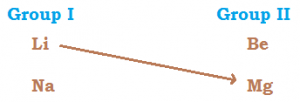- It is more harder and lighter than other alkali metals
- If is not affected by air easily and does not lose its lustre even on melting.
- It reacts slowly with water to liberate hydrogen.
- Lithium is the only alkali metal which directly reacts with nitrogen to form Li₃N
- Lithium hydroxide decomposes when heated to form Li₂O. Hydroxides of other alkali metals do not decompose.
2 LiOH → Li₂O + H₂O - LiHCO₃ is known in solution but not in solid state.
- LiHCO₃ is less stable, as it decomposes on heating.
LiHCO₃ → Li₂O + CO₂ + H₂O - LiNO₃ on heating gives a mixture of NO₂ and O₂ while nitrates of rest of alkali metals yield only oxygen.
4 LiNO₃ → 2Li₂O + 4NO₂ + O₂
2NaNO₃ → 2NaNO₂ + O₂ - Li₂SO₄ is the only alkali metal sulphate which does not form double salts.
- Lithium reacts with bromine very slowly, other alkali metals react violently.
- LiF, Li₃PO₄, Li₂C₂O₄, Li₂CO₃ are sparingly soluble in water.
- LiCl is highly deliquescent and soluble in alcohol and pyridine.
Lithium shows anomalous behavior due to the following reasons:
- Extremely small size of lithium atom and its ion.
- Greater polarizing power of lithium ion (Li+) due to its small size which results in covalent character in its compounds.
- Least electropositive character and highest ionization enthalpy as compared to other alkali metals.
Diagonal Relationship:
Similarities with Magnesium:
Lithium shows resemblance with magnesium, an element of group IIA. This resemblance is termed as diagonal relationship.

Reasons for the diagonal relationship:
- Electro negatives of Li and Mg are quite comparable.
- Atomic radii and ionic radii of Li and Mg are not much different.
- Atomic volumes of Li and Mg are quite similar.
- Both have high polarizing power.
Lithium and Magnesium resembles:
- Both Li and Mg are harder and have higher melting points than the other metals in their respective groups.
- Li like Mg decomposes water slowly to liberate hydrogen.
2Li + 2H₂O → 2LiOH + H₂
Mg + 2H₂O → Mg (OH)₂ + H₂ - Both the elements combine with nitrogen on heating
6Li + N₂ → 2Li₃N
3Mg + N₂ → Mg₃N₂ - Both Li and Mg combine with carbon on heating.
2Li + 2C → Li₂C₂
Mg + 2C → MgC₂ - Lithium forms monoxide when heated in oxygen. Mg also forms monoxide.
4Li + O₂ → 2Li₂O
2Mg + O₂ → 2MgO
Both the oxides are less soluble in water
